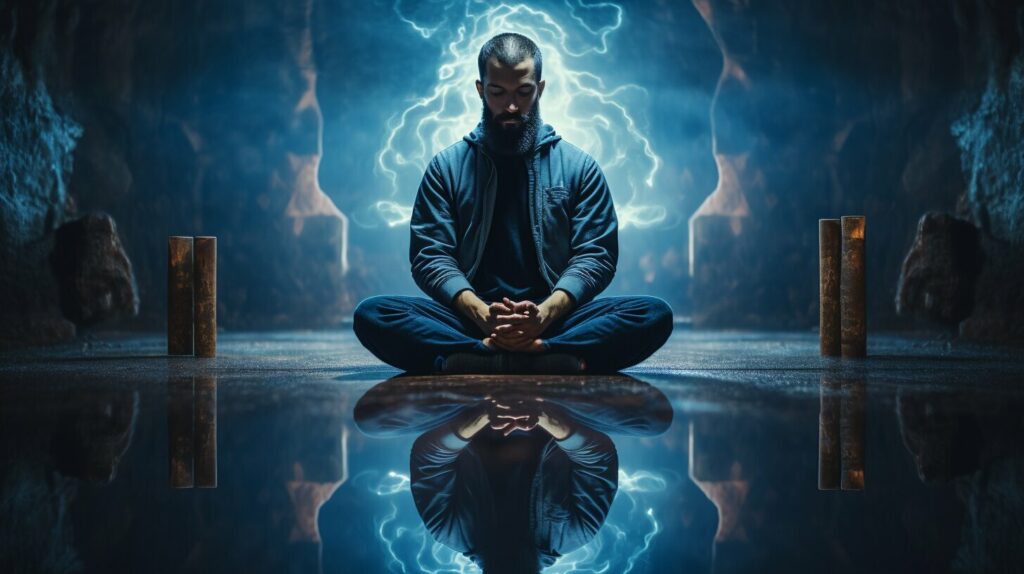Welcome to my latest article on lucid dreaming! As a copywriting journalist, I’ve been researching and experimenting with lucid dreaming for years. In this article, I’ll be discussing some of the mistakes you should avoid in lucid dreams, and offering tips and strategies for making the most out of your lucid dreaming experiences.
Lucid dreams can be incredible, life-changing experiences. However, like any powerful tool, they must be used responsibly. By avoiding certain mistakes, you can enhance your lucid dreaming experience and avoid potential pitfalls. So, let’s get started!
Key Takeaways:
- Lucid dreams can be incredible, life-changing experiences.
- Mistakes in lucid dreaming can lead to negative consequences.
- Avoiding certain mistakes can enhance your lucid dreaming experience.
Looking in a Mirror in a Lucid Dream: Proceed with Caution!
One of the most fascinating things about lucid dreaming is the ability to control and manipulate the dream environment. However, some experiences can be more challenging than others. One such experience is looking in a mirror during a lucid dream.
While it might seem like a harmless and exciting way to explore the dream world, looking in a mirror in a lucid dream can have unexpected consequences. For starters, the reflection in the mirror may not be accurate or may be distorted in some way, leading to confusion and discomfort. Additionally, some people report feeling a loss of control over the dream environment after looking in a mirror.
It’s important to approach mirror experiences in lucid dreams with caution and awareness. Instead of immediately jumping into the experience, take a moment to ground yourself and reaffirm your lucidity. Remind yourself that you are in control of the dream and that any experiences you have in the mirror are a reflection of your inner world.
Another helpful strategy is to set an intention before looking in the mirror. For example, you could intend to gain insights into an issue or challenge in your waking life, or to explore your self-perception and identity. By setting an intention, you give yourself a sense of direction and purpose for the mirror experience.
Finally, remember that you can always choose to look away from the mirror or exit the dream entirely if the experience becomes too intense or overwhelming. Trust your instincts and prioritize your well-being above any desire to explore the dream world.

Looking in a Mirror in a Lucid Dream: Proceed with Caution!
Mirror Gazing in Lucid Dreams: The Mirror Visualization Technique
One of the most fascinating experiences in lucid dreams is looking in a mirror. It can be an intense and revealing experience where we confront our self-image and explore the depths of our psyche. However, it can also be a challenging and unsettling experience, especially for beginners. To navigate mirror experiences in lucid dreams, we can use the mirror visualization technique.
The mirror visualization technique is a powerful tool for self-discovery and personal growth. It involves gazing into a mirror in a lucid dream and focusing on your reflection. This technique can reveal insights about your self-image, hidden fears, and unresolved emotions.
| Tip: | Before attempting the mirror visualization technique, make sure you have a stable and clear lucid dream environment. Ensure you are fully lucid and in control of the dream before approaching a mirror. |
|---|
Mirror Gazing Steps
- Find a mirror in your lucid dream. You can create one by visualizing it or ask a dream character to lead you to one.
- Look into the mirror and observe your reflection. Take note of any details, such as your facial expressions, body language, or clothing.
- Focus on your reflection and ask questions to gain insight, such as “What am I hiding from myself?” or “What can I learn from this dream?
- Acknowledge any emotions that arise during the mirror gazing. Don’t become attached to them, but observe them and allow them to pass.
- Thank the mirror and your reflection before leaving the dream.
The mirror visualization technique can provide a wealth of insights and self-awareness. It can help us confront our shadow self, reveal the inner workings of our psyche, and gain clarity on our goals and aspirations.
However, keep in mind that mirror gazing in lucid dreams should be approached with caution. It can be difficult to control the reflections in the mirror, and they may distort or become unsettling. If you feel uncomfortable or scared, look away from the mirror or close your eyes.
Next, we’ll explore the symbolic meaning of mirrors in dreams and how they can represent self-perception, introspection, and the subconscious mind.

Understanding the Symbolism of Mirrors in Dreams
Have you ever dreamt of looking in a mirror? If so, you may be curious about what this common dream symbol means. Mirrors in dreams can represent many things, from self-perception to introspection and even the subconscious mind.
When you see yourself in a dream mirror, you may be seeing a reflection of your true self, your inner thoughts, and emotions. It’s important to note, however, that the reflection may not be completely accurate or may be distorted in some way.
According to dream experts, mirrors in dreams can also represent a desire for self-exploration or a need to reflect on one’s life direction and choices. Sometimes, mirrors can also be a symbol of vanity or deception, so it’s essential to consider the context of the dream and one’s personal associations with mirrors.
Interpreting mirror experiences in dreams can be both challenging and rewarding. It requires tapping into your intuition, paying attention to your emotions, and exploring the symbolism of the dream. By doing so, you can gain valuable insights into yourself and your subconscious mind.
| Symbolism of Mirrors in Dreams | Meaning |
|---|---|
| Self-perception | The mirror represents how you see yourself, including self-image, self-esteem, and self-worth. |
| Introspection | You may be looking within yourself and exploring your thoughts, emotions, and subconscious mind. |
| Deception | The dream mirror may be warning you of deceit in your waking life or your tendency to deceive yourself. |
| Reflection | The mirror may be a symbol of your need for self-reflection and evaluation of your life choices and direction. |
Understanding the symbolism of mirrors in dreams can help you interpret your dreams more accurately and gain a deeper understanding of your inner self.

The Mirror Exercise for Lucid Dreaming: Enhancing Self-Awareness
The mirror exercise is a powerful tool for enhancing self-awareness in lucid dreams. This technique involves gazing into a mirror and exploring your reflection, allowing you to gain insights into your psyche and emotions.
To practice the mirror exercise, find a mirror within your dream and approach it with intention. Look deeply into the mirror and observe your reflection. Pay attention to any changes or distortions that occur, as these can provide valuable information about your subconscious mind.
| Step | Action |
|---|---|
| 1. | Find a mirror in your lucid dream. |
| 2. | Approach the mirror with intention. |
| 3. | Look deeply into the mirror and observe your reflection. |
| 4. | Pay attention to any changes or distortions in your reflection. |
| 5. | Ask the mirror a question or set an intention for your exploration. |
| 6. | Reflect on your experience and any insights gained. |
It’s important to approach the mirror exercise with a sense of curiosity and openness. Ask the mirror a question or set an intention for your exploration, and allow yourself to be open to whatever arises.
The mirror exercise can help you gain insights into your emotions, fears, and desires. It can also provide a safe space to explore and process difficult emotions.
Through regular practice of the mirror exercise, you can enhance your self-awareness, boost your dream recall, and deepen your overall experience of lucid dreaming.

Lucid Dreaming Self-Analysis: Exploring Inner Worlds
Lucid dreaming can be a powerful tool for self-reflection and personal growth. By becoming aware that you are dreaming and actively participating in the dream, you can access deeper levels of your consciousness and gain valuable insights into your inner world.
One of the most effective ways to use lucid dreaming for self-analysis is to set an intention before going to sleep. This could be a question you want to explore, a challenge you are facing in your waking life, or simply a desire to gain more clarity about yourself.
Once you become lucid in your dream, take a moment to ground yourself and focus on your intention. Then, start exploring your surroundings and interacting with dream characters and objects. Pay attention to your thoughts, feelings, and sensations, and try to identify any patterns or recurring themes.
As you engage in self-analysis in your lucid dreams, it can be helpful to keep a dream journal. Write down your experiences and any insights you gain, and reflect on them when you wake up. Over time, you may start to see connections between your dreams and your waking life, and use this knowledge to make positive changes.
The Benefits of Lucid Dreaming Self-Analysis
Lucid dreaming self-analysis can offer a range of benefits, including:
- Increased self-awareness and understanding
- Insight into unconscious patterns and behaviors
- Opportunities for emotional healing and resolution
- Greater clarity and perspective on life challenges
By exploring your inner world through lucid dreaming, you can gain a deeper appreciation for yourself and your place in the world. It can also be a fun and exciting way to expand your consciousness and explore the unknown.
Remember, lucid dreaming is a practice that takes time and patience to develop. Don’t get discouraged if you don’t become lucid right away, or if your self-analysis doesn’t yield immediate results. Keep practicing, stay curious, and trust that your mind holds infinite possibilities.

Common Mistakes to Avoid in Lucid Dreams
Lucid dreaming can be a fun and exciting experience, but it’s important to be mindful of certain actions that can lead to negative consequences. Here are some common mistakes to avoid in lucid dreams:
| Mistake | Why to Avoid it |
|---|---|
| Excessive Control | Trying to control every aspect of the dream can lead to frustration and limit the potential for exploration and creativity. |
| Ignoring Dream Characters | Dream characters can provide valuable insights and perspectives, even if they seem insignificant or annoying. |
| Being Reckless | Engaging in dangerous or harmful activities in a dream can have lasting psychological effects and diminish the quality of future dreams. |
| Not Setting Intentions | Without clear intentions and goals, lucid dreams can be directionless and lack meaning or purpose. |
By avoiding these mistakes and being intentional in your approach to lucid dreaming, you can enhance your overall experience and reap the benefits of this unique state of consciousness.

Overcoming Challenges in Lucid Dreaming: Tips and Strategies
Lucid dreaming can be an incredible experience, but it’s not always easy to navigate. Sometimes, we encounter challenges or obstacles that can make it difficult to maintain control over our dreams. Here are some tips and strategies that I’ve found helpful for overcoming common challenges in lucid dreaming:
1. Stay calm and focused
It’s easy to get excited or overwhelmed when you realize you’re in a lucid dream, but it’s important to stay calm and maintain your focus. Remember that you’re in control of the dream, and that you can adjust the narrative or setting as necessary. Take deep breaths, ground yourself in the present moment, and stay focused on your goals for the dream.
2. Practice dream stabilization techniques
One of the challenges of lucid dreaming is maintaining stability in the dream state. Sometimes, the dream can start to fade or collapse, making it difficult to stay in control. There are several techniques you can use to stabilize the dream, such as rubbing your hands together, spinning in circles, or focusing on a specific object. Find what works best for you and practice it regularly.
3. Experiment with different approaches to dream control
There’s no one-size-fits-all approach to controlling your dreams in a lucid state. Some people prefer to use visualization techniques or affirmations, while others rely on their own willpower or imagination. Experiment with different approaches to see what resonates with you, and be open to trying new things.
4. Address emotions and fears head-on
In lucid dreams, our emotions and fears can become amplified, sometimes to the point of overwhelming us. Don’t shy away from these experiences – instead, address them head-on. Confront your fears, explore your emotions, and use the dream state as an opportunity for personal growth and reflection.

5. Stay grounded in reality
While lucid dreams can feel incredibly real, it’s important to remember that they’re still just dreams. Don’t get so caught up in the dream state that you forget about your waking life or lose touch with reality. Use lucid dreaming as a tool for personal growth and creativity, but don’t let it consume you.
By following these tips and strategies, you can overcome common challenges in lucid dreaming and make the most of your dream experiences. Remember to be patient, stay curious, and approach your dreams with a sense of wonder and awe.
Conclusion
Lucid dreaming can be a powerful tool for exploring our inner worlds and gaining insights into our subconscious minds. However, it’s important to approach these experiences with caution and respect. Through this article, I’ve highlighted some common mistakes to avoid in lucid dreams, including looking in a mirror without preparation, and provided tips and strategies for overcoming challenges in the dream world.
Remember, the power of lucid dreaming lies in our ability to be intentional and mindful in our experiences. By practicing techniques like mirror gazing and the mirror exercise, we can deepen our self-awareness and foster personal growth. And by avoiding common mistakes and embracing new challenges, we can continue to expand our understanding of the dream world and ourselves.
So, are you ready to explore the world of lucid dreaming?
With these tips and strategies in mind, I encourage you to approach your dream experiences with curiosity and respect. Whether you’re a seasoned lucid dreamer or just beginning your journey, there’s always something new to discover.
So go ahead, close your eyes, and dive into the world of lucid dreaming. Who knows what insights and adventures await?
FAQ
Q: What are some things you should never do in lucid dreams?
A: It is important to avoid certain actions in lucid dreams to enhance the experience and prevent potential pitfalls. Some things you should never do in lucid dreams include:
Q: Should I look in a mirror during a lucid dream?
A: Proceed with caution when looking in a mirror during a lucid dream. There can be potential dangers and challenges, such as distorted or frightening reflections and loss of control over the dream. However, there are ways to navigate mirror experiences safely.
Q: What is the mirror visualization technique in lucid dreams?
A: The mirror visualization technique involves gazing into a mirror during a lucid dream to explore self-reflection and gain insights. This practice can be beneficial for self-awareness and personal growth in the dream state.
Q: What is the symbolism of mirrors in dreams?
A: Mirrors in dreams can symbolize self-perception, introspection, and the subconscious mind. It is important to interpret mirror experiences within the context of your personal dream symbols to understand their deeper meaning.
Q: How can I practice the mirror exercise in lucid dreams?
A: To practice the mirror exercise in lucid dreams, follow these steps: 1) Find a mirror within your dream; 2) Look into the mirror and observe your reflection; 3) Focus on self-awareness and explore the details of your reflection; 4) Reflect on the insights gained from the mirror experience.
Q: What is lucid dreaming self-analysis?
A: Lucid dreaming self-analysis is the practice of using lucid dreams as a tool for personal growth, emotional healing, and problem-solving. It involves analyzing and integrating insights gained from lucid dream experiences.
Q: What are common mistakes to avoid in lucid dreams?
A: Common mistakes to avoid in lucid dreams include: 1) Becoming too excited and waking up from the dream; 2) Losing lucidity and slipping back into a regular dream; 3) Engaging in risky or harmful behaviors without considering the consequences.
Q: How can I overcome challenges in lucid dreaming?
A: To overcome challenges in lucid dreaming, consider these tips and strategies: 1) Practice stability techniques to maintain lucidity; 2) Use dream control techniques to manipulate the dream environment; 3) Embrace and navigate intense emotions with mindfulness.
Q: What are the key takeaways from this article?
A: The key takeaways from this article are to be mindful and intentional in lucid dreams, avoid common mistakes, and explore self-analysis for personal growth. It is important to approach lucid dreaming with respect and responsibility.






